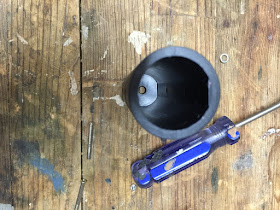Piranha Power Pole
Replacement kit
This is a write up of the Power Pole Replacement kit
(Manufacturer part number PP-LV-G). The Power Pole is currently my main pole
since the end has two sets connection slots. This is usually
a problem area (the attachment tools eventually breakdown the connectors) so having a second set helps to extend the life of the pole.
As with any swimming pool pole certain parts seem to ware
out so the makers of the Power Pole released a pack of the most common fixes to their pole. In this specific case the rubber handle on the end of my pole
finally wore down and fell off. This kit came with more then just the handle
(Lever springs and internal stopper) and all but one was used in this writeup.
Since my poles handle had already fallen off I did not need
to remove anything to start.
The new handle just slides on, note that the inside is not perfectly
round, and there is a flat side that lines up with the flat side of the pole.
Once on the screws are inserted and tightened.
Note: Originally the screws on mine fell out before the
handles end was worn down. So I added some gorilla glue to the screws before
inserting them. (I assemble this kit about 6 months ago and this worked out
well as the screws are still in their correct place)
The inside pole is supposed to stop from before being fully
removed from the outer pole via a internal stopper. The kit comes with a replacement internal stopper,
mine was in good condition yet I still replaced it since it was included. With the handle off, the inner pole is pushed down and out through the bottom of the outer pole to view the old stopper.
The the old stopper was removed and the new set in its place.
If your poles internal spring breaks this kit does come with a replacement that looks like it would be easy to replace (instructions were on the box). I did not replace the lever spring since I didn’t see the
point. On the past Power Pole I had there was never a problem with the lever,
it was the center pole holes there were becoming egg shaped that was the problem.
As seen in the picture below this poles hole are starting to become egg shaped.
If you
have a Power pole with either the handle, the lever spring or the center pole pulls out
of the top of the outer pole this kit will fix those. But if your center pole holes
are becoming egg shaped causing the inner pole to slip out of the locked positions this kit will not help with that.


























































